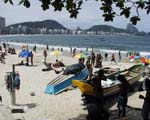
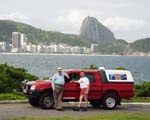
Copacabana Fort, ready for the off
Flew into Rio to be met by our terrific Brazilian helpers José and Mahar, together with Jingers. They and our agent had done sterling work to get our vehicle 'liberated' from Brazilian customs in record time.
This was due in part to the great help of officials in Brasilia, including the Head of the Customs Service, who has issued a Protocol declaring the Inca Trail an event of national interest. Things would have gone even better if he and the local customs head hadn't both gone on holiday without briefing the guys left in charge!
Overnight at the Sofitel Rio Palace, the superb rally HQ hotel on Copacabana Beach. Sadly no time for a dip, but had a quick ogle. Visited Copacabana Fort, on the headland between Copacabana and Ipanema beaches - one of Rio's most historic sites and a spectacular setting for scrutineering and the start.
 |
 |
|
|
Copacabana Fort, ready for the off |
Day Two - Saturday 22 January
Time to introduce my travelling companions. Jingers is Tim Riley, well known to many long distance classic rallyists as an ace car builder and fixer who has been sweeper on events such as Peking - Paris and London - Cape Town. He and I drove the length of Africa two years ago, from the Red Sea to the Cape of Good Hope, for the London - Cape Town route survey.
Rallying is literally in his blood: his father is Peter Riley, famous works driver in the 1950s and 1960s for BMC and Ford; his mother, as Ann Wisdom, was Pat Moss's co-driver; his grandfather was Tommy Wisdom, celebrated rallyist, racer, journalist, raconteur and bon viveur; and Tommy's wife 'Bill' accompanied him on many events.
Mitzi is our vehicle. She is a red LHD Mitsubishi L-200 four-door pick-up, powered by a 2.5 litre turbo diesel with intercooler. Peter Rushforth of the Left Hand Drive Place - another stalwart of the HERO organising team who rides course opening car on most of our rallies - bought her for me in Belgium just before Christmas, and broke all records in getting her UK registered. Her real name is V576 FPF.
Neither Jingers nor I speaks Portuguese, so for the Brazilian part of the trip we have been joined by Roberto, José's nephew, who is a graphic designer by trade. He has made some nice Route Survey letters for the side of the car.
All this gossip is to disguise the fact that today was rather disappointing. It started well enough, with a run up the spectacular main road that winds up to the old town of Petrópolis, but the town itself proved to be choked with traffic and less interesting than we had hoped. We decided to bypass it and go straight to the first regularity section, on 30 km of good asphalt twisting though some amazing mountains.
After this, we explored a number of gravel roads through green hills that looked promising on the maps, but all proved to be too rough. By the time it got dark, we had made little progress, so started looking for a hotel. All we could find was a brightly lit motel.
Roberto sounded doubtful, with good reason: like all motels in Brazil, it was an out and out knocking shop, letting rooms by the hour. They were quite startled when we asked for three singles.
But the rooms themselves were comfortable and well equipped, complete with mirrors on the ceiling, so we did at least get a good night's rest.
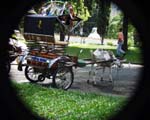 |
|
|
Day Three - Sunday 23 January
After we enter the province of Minas Gerais, our luck changes. This part of Brazil is very beautiful countryside of green hills. We have found a great 75 km medal section for the postwar classics, and a wonderful run of 47 km for the 4x4s, both of them through lovely landscapes and characterful little towns and villages.
Signposts are few and maps are pretty hopeless, so we frequently have to ask the way, especially through towns. Without Roberto's Portuguese, we would have been lost - literally! Jingers wonders whether the participants realise how much trial and error, how many kilometres of toing and froing, go into making up the road book which wafts them effortlessly through labyrinths of town streets and confusing networks of country gravel tracks.
We stopped for lunch at a little local bar in the town of Ubá. The proprietor had a group of his friends in to sing Brazilian love songs - he had a great voice. The food was excellent, too. The sort of surprise that makes travel different from tourism.
We came into Ouro Prêto after dark, but could still see that this town is different. In the main square, we were accosted by a lad of about 12 who offered to guide us to our hotel. He ran in front of us up and down the steep, narrow cobbled streets - as Jingers said, they must be fit here!
We stayed in one of Ouro Prêto's historic inns. A lovely place - shame it's too small for a rally.
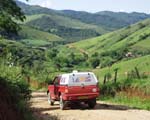 |
 |
|
|
|
Day Four - Monday 24 January
Daylight revealed the full glory of Ouro Prêto. This is one of the world's finest preserved cities - a maze of cobbled streets and little 17th and 18th century houses set on steep hillsides, dominated by a dozen magnificent churches which reflect the wealth of this mining community when they were built - Ouro Prêto means Black Gold.
We are warmly welcomed by the town's Director of Tourism with generous promises of help, including the use of the superb main square as the rally car park. We look at a few more small typical hotels before discovering a beautiful resort complex just outside town which will accommodate us all.
Ouro Prêto has utterly captivated us, and is much too big to be seen during a short and pressured overnight halt, so we are thinking of starting a day earlier from Rio and having a day off here.
We didn't roadbook the various alternative routes into Ouro Prêto yesterday, so tonight, we had to back track 200 km to Ubá, ready for an early start tomorrow.
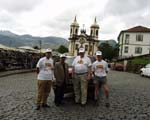 |
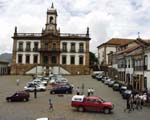 |
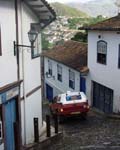 |
|
|
|
|
Day Five - Tuesday 25 January
Various niggles meant we didn't manage that early start, but we did find another nice medal section. In Ubá we spotted an MG TF - until we got close and saw it was a fibreglass replica called an MP, based on a VW Beetle platform and running gear! Roberto told us that hundreds were built in the 1970s.
Stayed in our Ouro Prêto rally hotel - very comfortable and good food.
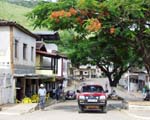 |
|
|
Day Six - Wednesday 26 January
Took a new road out of Ouro Prêto through the mountains - still being built. Then across rolling farmland to the picturesque old world village of Tiradentes - there's a great 20 km regularity section on little gravel roads just before it.
Brazil is much more like Europe than Africa, with prosperous farms. The scenery is varied, but almost always attractive. The scare stories we had been told about diesel fuel proved completely unfounded: it's available at virtually every filling station, anyone can buy it and it costs about 30 US cents (20p) a litre. The best petrol is 70 US cents, but almost all Brazilian gasoline has a percentage of alcohol. About half the bigger stations take MasterCard or Visa - the latter is more widely accepted.
We stayed in the pleasant little town of São Lourenço, the source of Brazil's only naturally sparkling mineral water.
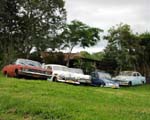 |
|
|
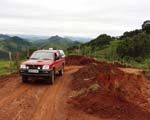 |
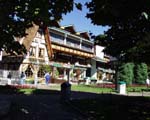 |
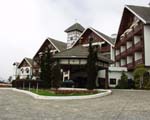 |
|
|
|
|
Day Eight - Friday 28 January
The asphalt road that winds up to Campos is scenic, twisty and will make a great regularity. Found a nice 35 km medal section, too.
Tonight we ended up in a small chalet hotel in a little country town, and has a wonderful meal at the local café. We were regaled by a group of young locals singing traditional love songs - much nicer than karaoke. Then in came a distinguished gentleman and his wife, speaking perfect English, curious about a British registered vehicle in their remote place. He turns out to be Oscar, Pilkington's top man in South America, who has a hilltop home close by. When he finds out about Classic Malts, he nips home for his bottle of Lagavulin, in which we make a significant hole. He has kindly agreed to show us a 4x4 section tomorrow.
Day Nine - Saturday 29 January
A great day. Oscar's 4x4 section is brilliant, and we have discovered a superb medal section of 63 km through beautiful mountains and forests.
We spent the night in Campinas, where Roberto takes us to eat at a local churrasqueria. There's no menu; waiters circulate with different cuts of meat and other delicacies skewered on swords, and carve you off a slice of anything you fancy. There's also a copious salad bar. Just the place for a good pig-in after a long day.
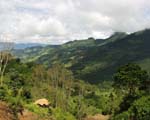 |
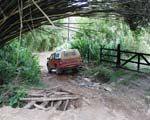 |
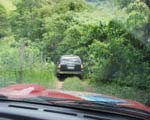 |
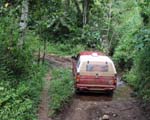 |
|
|
|
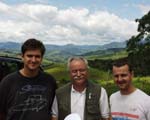 |
|
|
|
|
Day Ten - Sunday 30 January
Our action in Brazil so far has been in the hills and mountains that lie parallel to the coast between Rio and São Paulo, but now we have headed inland across the great rolling hinterland, on excellent motorways and main roads to the city of Londrina, named after London.
We have bought a supply of superb German sausages from a roadside shop at the German community of Warta. They will make great sandwich filling for the next two or three days.
Day 11 - Monday 31 January
In Londrina, as in each of the rally's overnight halts, we inspect all the hotels the rally may use, and negotiate rates. We have to identify a site for a control, preferably at a prominent location in the centre, and get permission for its use. We have to make sure that the hotels have sufficient secure parking, or if not find an overnight car park which can be well guarded. Here, both our chosen hotels have arrangements with large covered car parks close by (as well as swimming pools). We find a good Main Control site in a pretty garden next to the cathedral.
At each place, we also try and meet an official of the town such as the head of tourism, to get official local support for the Inca Trail, which is virtually always readily forthcoming. Here, the tourism lady promises us that all will be made available, and rings the President of the local classic car club. He comes immediately to her office, and assures us that his members will help us, and will bring their cars out to meet us.
He puts us in touch with the director of the local race circuit, which we go and see. It's an interesting 3 km track with gradients as well as curves. The director agrees to let us put on a lap time consistency test, and will provide their regular race timekeepers.
In addition to all that, we have the complex task of making a roadbook into and out of the town, and to each hotel, choosing the best route from a maze of one-way streets.
To do all this, we typically have to spend a day at each town which is a rally overnight halt.
Today, we also had to note the 500 km of main roads to Foz do Iguaçu. On the way, we explored in torrential rain a couple of roads which on the map looked like possible regularity sections, but had to turn back as they deteriorated into quagmires. The competitors will have to make do this day with the circuit test and an afternoon at the Foz. We finally arrived around midnight.
Day 12 - Tuesday 1 February
Fine weather for a wonderful day. Foz do Iguaçu is one of the world's big three among waterfalls, along with Niagara and Victoria Falls, but is far more extensive than either, being some 2 km from one side to the other. In this distance, there are many individual falls which are quite different from each other, the most impressive being the northernmost.
The falls divide Brazil from Argentina, and each country has provided networks of well paved paths and walkways stretching out across the water to viewing platforms. That on the Brazilian side takes at least an hour to see, and is probably the more impressive; but the Argentine network is more extensive, going to the very edge at the top of some falls.
The area is full of wildlife. Coati - smallish mammals with long ringed tails - plague the car parks and the rubbish bins. I saw a black and white lizard the size of a cat in the hotel gardens. Big spiders were sitting on invisible webs right alongside the falls path.
Our hotel last night on the Brazilian side was the traditional Tropical das Cataratas, a colonial-style building reminiscent of the Victoria Falls Hotel. It is a lovely place, with all amenities, just a few feet from the falls walk.
Tonight, having put Roberto on the plane back to Rio, Jingers and I are staying on the Argentine side in the brashly modern Sheraton Internacional Iguazú, directly overlooking the falls and currently undergoing renovation. Either can take the whole rally, and we will have to make a difficult choice.
The border crossing had threatened to be protracted, as on the Argentine side - having passed quickly through immigration and Carnet processing - we were chosen for the full Customs search. We had been there 20 minutes while they got stuck into the car in front, so as they had only just reached the ladies' underwear department, I decided to show the lady in charge the letter saying that the Secretary of State for Tourism had personally declared the Inca Trail an Event of National Interest. 'Why didn't you say so before'', she said, and waved us through.
 |
||
|
|
||
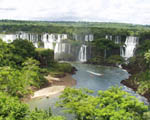 |
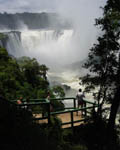 |
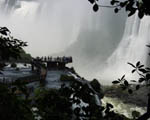 |
|
|
||
 |
||
|
|
||
Next: Foz do Iguaçu to Jujuy (to be posted Monday 6 March)